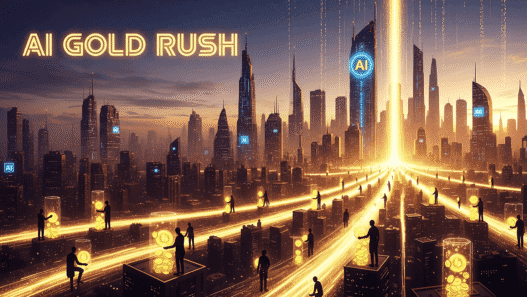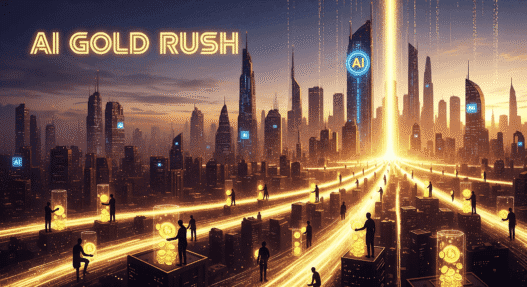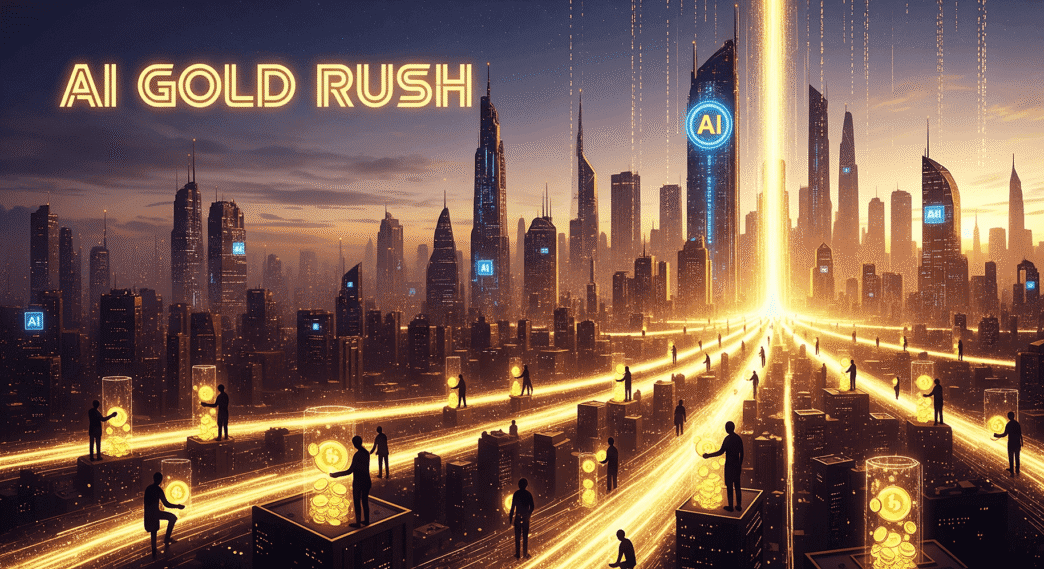Welcome to the AI Gold Rush

Have you noticed how the world suddenly feels like it’s moving at lightning speed? Artificial Intelligence (AI) is at the center of this transformation, and it’s creating wealth at a scale humanity has never witnessed before. Many call it the AI Gold Rush, and that’s exactly what it is-a modern-day version of the California gold rush, but this time the “gold” is digital intelligence.
From freelancers who are doubling their income to startups that grow into billion-dollar businesses overnight, AI is generating fortunes for those who know how to use it. And here’s the best part: this wealth explosion isn’t limited to tech billionaires, it’s happening at every level of society.
In this article, I’m going to explain step by step how the AI Gold Rush is making people rich, why it matters, and how you can position yourself to benefit from it.
Level 1: Everyday Workers Using AI for Productivity

Not everyone in the AI gold rush is launching startups or training billion-dollar models. For many people, AI is simply a tool that helps them keep their jobs and perform better.
Think of a marketing agency employee. Their daily tasks include brainstorming ad ideas, writing endless emails, and preparing presentations. Normally, this workload could feel overwhelming, but with AI tools like ChatGPT, what used to take hours now takes minutes.
- Emails? Generated in seconds.
- Ad copy? Written with creative alternatives instantly.
- Presentations? Designed with AI-powered templates.
This means employees who adopt AI are working smarter, not harder. They become more efficient, deliver higher-quality results, and stand out from colleagues who refuse to adapt.
But here’s the reality check: simply using AI to keep up is no longer enough. In today’s market, being good at your job isn’t enough anymore. If your coworker is using AI and you aren’t, you’re already behind.
???? Takeaway: In the AI Gold Rush, workers who leverage AI are not just surviving, they’re ensuring their relevance in an economy that rewards speed, efficiency, and adaptability.
Level 2: Freelancers and Independent Professionals Scaling Income

If AI is a survival tool for employees, it’s a wealth multiplier for freelancers and consultants.
Two years ago, a freelance web developer might have spent days coding a new feature for a client-reading documentation, fixing bugs, and testing everything manually. Today, with AI-powered tools like GitHub Copilot, they can simply describe what they want in plain English and have the code generated instantly.
This means:
- Instead of juggling 2 clients, they can now handle 10.
- Instead of spending weeks on small updates, they deliver projects in days.
- Instead of just keeping up, they’re scaling their output and income exponentially.
For independent workers, the AI Gold Rush isn’t just about efficiency, it’s about creating a competitive edge that allows them to deliver more value while working fewer hours.
Level 3: One-Person AI Businesses

The most exciting shift is happening with solopreneurs. In the past, running a successful business required hiring staff, managing teams, and scaling operations. But today, AI tools are acting as “digital employees,” allowing a single person to operate like a full-fledged company.
Take the example of a fitness coach:
- Marketing: AI writes newsletters, creates social media posts, and repurposes video content into dozens of short clips.
- Operations: AI tracks client progress, predicts engagement trends, and automates reporting.
- Customer Service: An AI chatbot trained on the coach’s expertise answers client questions 24/7.
This model is called One Founder, Ten Automations, Infinite Reach. A single person, leveraging multiple AI tools, can operate at a scale that previously required entire teams.
???? Takeaway: In the AI Gold Rush, individuals are running “micro-empires” powered by AI, blurring the line between a solo freelancer and a full-scale company.
Level 4: Selling the Shovels, AI Tool Builders

There’s an old saying: “During a gold rush, don’t dig for gold-sell the shovels.”
That’s exactly what smart entrepreneurs are doing in the AI economy. Instead of just using AI, they’re building AI-powered tools that solve specific problems.
With no-code development platforms and tools like Cursor, Windsurf, and Lovable, people are creating apps without writing a single line of code. These tools can:
- Turn YouTube videos into short-form content automatically.
- Build personalized workout trackers.
- Generate financial health reports based on user data.
The beauty of these apps is their simplicity. They solve very narrow problems, require little maintenance, and can generate passive income.
???? Takeaway: In the AI Gold Rush, the people selling “AI shovels”-the tools, are often the ones getting rich the fastest.
Level 5: Startups Built Entirely on AI

Some entrepreneurs go even further by making AI the foundation of their products, not just a feature.
- Rewind: A memory tool that records and organizes everything you see or say on your computer, making it searchable-like a Google for your brain.
- Runway: A company reinventing video editing by letting creators generate complex effects using simple text prompts.
These startups are not just using AI, they are AI. Their products wouldn’t exist without artificial intelligence at their core.
And here’s why this matters: Investors know these companies are the future giants of tech. They’re pouring billions into AI-first startups because whoever sets the rules of AI will control the digital economy of tomorrow.
Level 6: The Titans of AI Models

At the top of the pyramid are the companies building the base AI models, the true infrastructure of the AI gold rush.
- Google with Gemini, integrating AI into Docs, Sheets, Gmail, and Search.
- Anthropic with Claude, a model focused on safety and alignment.
- OpenAI with ChatGPT, the platform that started this revolution.
Most of the AI tools people use are built on top of these foundation models. Think of them as the electricity that powers an entire city, every business may look different on the surface, but at the end of the day, they’re all paying the same power company.
???? Takeaway: The companies creating AI base models don’t just participate in the gold rush, they own the land everyone is digging on.
Level 7: The Infrastructure Giants (The Real Winners)

Now we arrive at the hidden winners of the AI economy, the companies providing the infrastructure. Without them, there would be no AI revolution.
- ASML – A Dutch company with a monopoly on ultraviolet lithography machines, which carve billions of transistors into chips. Without ASML’s $200M+ machines, modern AI chips simply wouldn’t exist.
- TSMC – The world’s leading semiconductor manufacturer, producing chips for Nvidia, Apple, and Google. They are the “mines” of the AI gold rush, supplying the silicon that powers everything.
- Nvidia – Once known for gaming GPUs, Nvidia now dominates the AI hardware market. Their H100 chips are the backbone of AI training, powering ChatGPT, Gemini, Claude, and more. Nvidia’s market cap has crossed $3 trillion, fueled by AI demand.
These companies are not chasing AI gold. They are the ground everyone else is digging on. No matter who wins in the AI startup race, these infrastructure giants will always get paid.
Don’t Get Left Behind in the AI Gold Rush

The AI Gold Rush is here, and it’s already creating millionaires and billionaires across every sector. From employees boosting productivity, to freelancers scaling income, to solopreneurs running AI-powered businesses, and finally to trillion-dollar infrastructure giants, the opportunities are everywhere.
But here’s the truth: the AI Gold Rush is not slowing down. If you’re not leveraging AI in your work, your business, or your investments, you’re at risk of being left behind.
The future belongs to those who embrace AI, adapt quickly, and build with it. Whether you’re an employee, a freelancer, or an aspiring entrepreneur, now is the time to take action.
If you enjoyed this guide and want more insights on money, investing, and building wealth, visit Forcefall.com for more in-depth articles and resources.














